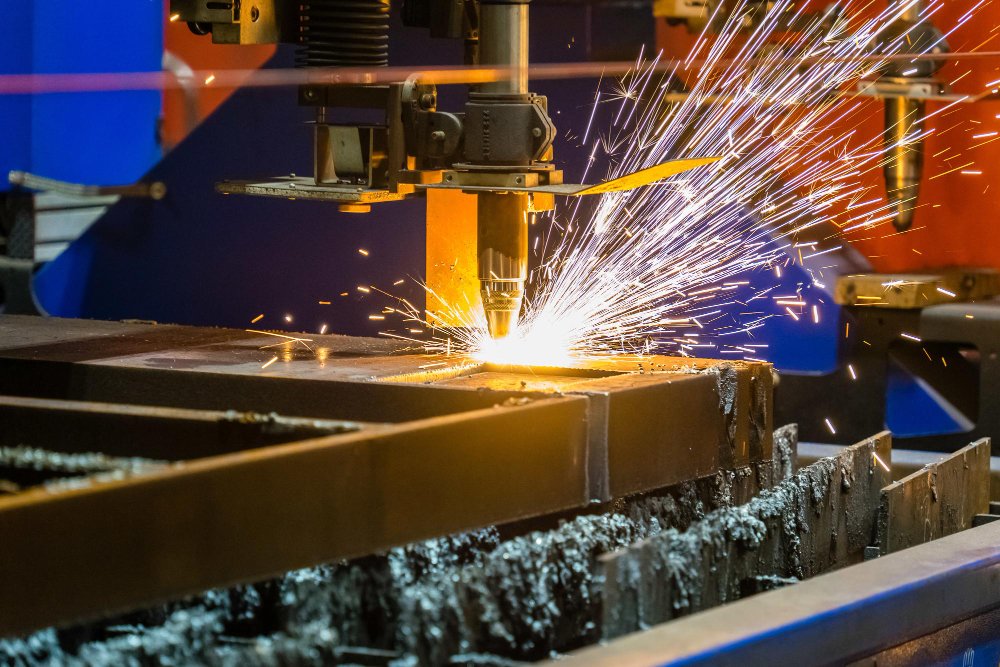The Future of Fabrication: Laser Metal Cutting Solutions for Every Need
- 1 Laser Metal Cutting Solutions for Every Need
- 2 Applications Across Industries
- 2.1 1. Automotive Industry
- 2.2 2. Aerospace Industry
- 2.3 3. Medical Device Manufacturing
- 2.4 4. Electronics Industry
- 2.5 5. Jewelry and Fashion
- 2.6 6. Construction and Architecture
- 2.7 7. Renewable Energy
- 3 Advantages of Laser Metal Cutting
- 3.1 1. Precision and Accuracy
- 3.2 2. Speed and Efficiency
- 3.3 3. Versatility
- 3.4 4. Quality and Finish
- 3.5 5. Automation and Integration
- 3.6 6. Cost-Effectiveness
- 3.7 7. Safety and Environmental Benefits
- 4 Customization and Innovation
- 5 Conclusion
The fabrication industry is experiencing a groundbreaking transformation with the introduction of laser metal cutting technology. This innovation enhances precision engineering and unlocks new possibilities for artistic expression. Laser metal cutting solutions revolutionize fabrication, delivering unparalleled accuracy, efficiency, and versatility. This article explores the remarkable capabilities, diverse applications, and significant benefits of laser metal cutting. We examine how this technology addresses every fabrication need, from intricate designs to large-scale industrial projects, ensuring optimal performance and quality in every task. Additionally, we investigate the impact of laser metal cutting on various industries, including automotive, aerospace, and construction, highlighting its pivotal role in driving advancements and fostering creativity.
Laser Metal Cutting Solutions for Every Need
Understanding Laser Metal Cutting Technology
Laser metal cutting utilizes a high-powered laser beam to precisely slice through various metals, such as steel, aluminum, and titanium. This advanced technology focuses a concentrated light beam on the metal’s surface, causing it to melt, vaporize, or burn away, resulting in a clean and accurate cut. Controlled by computer numerical control (CNC) systems, the process ensures exceptional precision and repeatability. The versatility and efficiency of laser metal cutting make it ideal for a wide range of applications, from industrial manufacturing to artistic creation. It is extensively used in the automotive, aerospace, and electronics industries, as well as in custom metalwork and decorative art.
Applications Across Industries
The versatility of laser metal cutting technology makes it indispensable across numerous industries in Utah. In aerospace, it enables precision machining of aircraft components and engine parts. The automotive sector employs this technology to manufacture intricate car body panels and chassis components. In architecture, laser metal cutting facilitates the creation of stunning metal facades and decorative elements. From healthcare to consumer electronics, the applications of laser metal cutting are extensive, showcasing its adaptability and efficiency across diverse sectors.
1. Automotive Industry
The automotive industry was one of the earliest adopters of laser metal cutting technology. The precision and speed offered by laser cutting have significantly enhanced manufacturing processes. Critical applications in this sector include:
- Body Panels and Structural Components: Laser cutting fabricates body panels, chassis components, and other structural parts accurately, ensuring a perfect fit and finish. This results in improved vehicle quality and performance.
- Prototyping and Customization: Laser cutting allows for rapid prototyping and customization of parts, facilitating the development of new models and tailored solutions for specific markets or customer preferences.
- Complex Geometries: The ability to quickly cut complex shapes and designs makes laser cutting ideal for producing intricate automotive components that require precision.
2. Aerospace Industry
In the aerospace industry, where precision and reliability are paramount, laser metal cutting plays a crucial role. The applications in this sector include:
- Aircraft Components: Laser cutting is used to manufacture various aircraft components, such as engine parts, fuselage panels, and intricate turbine blades. The high precision ensures that each element meets stringent quality standards.
- Weight Reduction: Laser cutting enables the production of lightweight parts with complex geometries, contributing to overall weight reduction in aircraft. This leads to improved fuel efficiency and performance.
- Maintenance and Repair: Laser cutting is also employed to maintain and repair aircraft parts, providing a fast and efficient method to replace or refurbish damaged components.
3. Medical Device Manufacturing
The medical field demands exceptional precision and hygiene in producing devices and instruments. Laser metal cutting meets these requirements through the following applications:
- Surgical Instruments: Laser cutting is used to manufacture high-precision surgical instruments, such as scalpels, forceps, and scissors. The technology ensures sharp edges and precise dimensions.
- Implants and Prosthetics: Custom implants and prosthetics, tailored to individual patients, are produced using laser cutting. This allows for perfect fitting and improved patient outcomes.
- Medical Equipment: Components of complex medical equipment, such as MRI machines and surgical robots, are fabricated using laser cutting, ensuring reliability and accuracy.
4. Electronics Industry
In the fast-paced electronics industry, laser metal cutting offers several advantages that enhance the production of electronic devices:
- Printed Circuit Boards (PCBs): Laser cutting is used to create intricate designs on PCBs, ensuring precision in placing electronic components. This improves the overall functionality and reliability of electronic devices.
- Enclosures and Casings: The technology fabricates metal enclosures and casings for electronic devices, providing a high-quality finish and precise cutouts for connectors and buttons.
- Miniaturization: As electronic devices become smaller and more compact, laser cutting allows for the precise fabrication of tiny components essential for modern gadgets.
5. Jewelry and Fashion
Laser metal cutting has also made significant inroads into the jewelry and fashion industries, enabling the creation of intricate and customized designs:
- Jewellery Design: Laser cutting allows jewelers to produce intricate and detailed designs with precision, enabling the creation of unique and personalized pieces. This technology is especially beneficial for cutting precious metals like gold, silver, and platinum.
- Fashion Accessories: Designers use laser cutting to create metal fashion accessories, such as belts, buckles, and decorative elements. The precision and versatility of laser cutting facilitate the production of innovative and intricate designs.
- Customization: The ability to produce designs quickly and accurately has made laser cutting popular in the fashion industry, allowing designers to experiment with new styles and trends.
6. Construction and Architecture
In the construction and architecture industries, laser metal cutting has become an invaluable tool for creating complex and aesthetically pleasing structures:
- Structural Components: Laser cutting fabricates structural components, such as beams, columns, and trusses, with high precision. This ensures a perfect fit and enhances buildings’ overall stability and strength.
- Architectural Details: Intricate architectural details, such as decorative panels, screens, and facades, are produced using laser cutting. This allows architects to bring their creative visions to life precisely and accurately.
- Custom Solutions: Laser cutting facilitates the production of custom solutions for construction projects, creating unique and tailored designs that meet specific requirements.
7. Renewable Energy
The renewable energy sector, particularly in the manufacturing of solar panels and wind turbines, benefits from the precision and efficiency of laser metal cutting:
- Solar Panels: Laser cutting produces metal frames and support structures for solar panels. The precision and speed of laser cutting help maintain the quality and efficiency of solar panels.
- Wind Turbines: Components of wind turbines, such as the blades and the tower structure, are fabricated using laser cutting. The technology ensures the production of robust and durable parts that withstand harsh environmental conditions.
- Energy Storage Systems: Laser cutting is also employed in manufacturing components for energy storage systems, such as battery casings and connectors, ensuring high precision and reliability.
Advantages of Laser Metal Cutting
Laser metal cutting offers numerous advantages over traditional methods. It delivers unmatched precision, enabling fabricators to create intricate designs and tight tolerances with minimal material waste. This high accuracy stems from advanced laser technology, which produces excellent cuts. Laser metal cutting is also highly efficient, boasting rapid processing speeds that shorten lead times and boost productivity. The process can be easily automated, reducing the need for manual intervention and minimizing errors and inconsistencies.
1. Precision and Accuracy
One of the most significant advantages of laser metal cutting is its unparalleled precision and accuracy. The technology uses a highly focused laser beam to cut materials, resulting in minimal deviations from the desired dimensions. This precision is crucial for industries where exact measurements are critical, such as aerospace, medical device manufacturing, and electronics.
- Tight Tolerances: Laser cutting can achieve extremely tight tolerances, often within a few micrometers. This level of accuracy ensures that components fit perfectly, reducing the need for additional machining or finishing.
- Complex Geometries: The precision of laser cutting allows for the creating of intricate shapes and complex geometries that would be challenging or impossible to achieve with traditional cutting methods.
2. Speed and Efficiency
Laser metal cutting is known for its high cutting speeds, significantly enhancing production efficiency. Laser cutting speed translates into faster turnaround times and increased productivity, making it an ideal choice for high-volume manufacturing.
- Rapid Processing: Laser cutting is much faster than mechanical cutting methods, reducing production time. This is particularly beneficial for industries with tight deadlines and high demand.
- Minimal Setup Time: Laser cutting systems require minimal setup time compared to traditional cutting tools. Once the design is programmed into the machine, the cutting process can begin immediately, improving efficiency.
3. Versatility
Laser metal cutting is highly versatile and can cut various materials and thicknesses. This adaptability makes it suitable for multiple applications across different industries.
- Material Compatibility: Lasers can cut through various metals, including steel, aluminum, copper, and titanium, as well as non-metallic materials, like plastics, ceramics, and composites. This versatility allows manufacturers to use a single cutting technology for multiple materials.
- Thickness Range: Laser cutting can handle a broad range of material thicknesses, from thin sheets to thick plates, making it suitable for diverse applications.
4. Quality and Finish
The quality of cuts produced by laser cutting is superior to many traditional methods. The high precision and controlled heat input result in clean, smooth edges with minimal burrs or deformation.
- Reduced Post-Processing: The high-quality finish achieved by laser cutting often eliminates the need for additional post-processing steps, such as grinding or deburring, saving time and reducing costs.
- Minimal Distortion: Laser cutting uses a concentrated beam of light, transferring less heat to the surrounding material. This minimizes thermal distortion and warping, preserving the integrity of the material.
5. Automation and Integration
Modern laser cutting systems are highly automated and can be easily integrated into existing manufacturing processes. This automation offers several benefits:
- Reduced Labor Costs: Automated laser cutting systems require less manual intervention, reducing labor costs and the risk of human error.
- Consistent Quality: Automation ensures consistent quality across all produced parts, maintaining high standards and reducing variability in the manufacturing process.
- Advanced Software Integration: Laser cutting machines can be integrated with CAD/CAM software, allowing seamless design-to-production workflows. This integration enhances efficiency and allows for rapid adjustments to designs as needed.
6. Cost-Effectiveness
Although the initial investment in laser cutting technology can be high, the long-term cost benefits are substantial. The efficiency, precision, and reduced need for additional processing result in lower production costs.
- Material Utilization: Laser cutting optimizes material utilization by minimizing waste. The precision of the cuts ensures that material is used efficiently, reducing scrap and saving costs.
- Energy Efficiency: Modern laser cutting systems are designed to be energy-efficient, reducing operational costs over time.
7. Safety and Environmental Benefits
Laser cutting offers several safety and environmental advantages compared to traditional cutting methods.
- Safety: Laser cutting is a non-contact process, which reduces the risk of accidents and injuries associated with mechanical cutting tools. The automated nature of the process also means less operator involvement, further enhancing safety.
- Environmental Impact: Laser cutting produces less waste and consumes less energy than traditional cutting methods. Additionally, the precision of laser cutting reduces the need for rework and scrap, contributing to a more sustainable manufacturing process.
Customization and Innovation
One of the most thrilling aspects of laser metal cutting is its potential for customization and innovation. Utilizing advanced CAD/CAM software and CNC-controlled laser cutting machines, fabricators can transform their creative visions into reality with exceptional precision and detail. From intricate signage and personalized jewelry to bespoke architectural elements, laser metal cutting unlocks endless possibilities for customization and innovation. This empowers fabricators to distinguish themselves in a competitive market.
Conclusion
Laser metal cutting technology transforms the fabrication landscape by offering unparalleled precision, efficiency, and versatility across various applications. In aerospace, it enables the creation of intricate components with exceptional accuracy. In architecture, it brings complex designs to life with stunning detail. The advantages of laser metal cutting are clear across industries, driving innovation by reducing waste, cutting production time, and enhancing the final product’s quality. This advanced technology is shaping the future of manufacturing, allowing companies to tackle complex projects quickly. Laser metal cutting stands at the forefront of fabrication, poised to meet every need with precision and excellence, ensuring that industries continue to push the boundaries of what is possible.



















